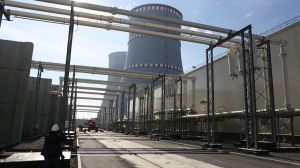Belarusian nuclear power plant's resilience to earthquakes explained

MINSK, 9 September (BelTA) – The Belarusian nuclear power plant is quite resilient to earthquakes, BelTA learned from Sergei Tretyakevich, Deputy Head of the Nuclear Safety Regulation Office of the Nuclear and Radiation Safety Department of the Belarusian Emergencies Ministry (Gosatomnadzor), at a press conference on 9 September.
Stress tests of the Belarusian nuclear power plant were carried out in 2016. The ability of the Belarusian nuclear power plant to withstand extreme weather phenomena and their combinations (earthquakes, tsunamis, and the rest) was examined after the accident at the Japanese nuclear power plant Fukushima. Close attention was paid to the seismic impact, Sergei Tretyakevich said. The Belarusian nuclear power plant is designed to survive an earthquake of up to 6 points strong. Seven points is the limit: the nuclear power plant will not work but will remain safe. The national action plan, which was compiled in the wake of the stress tests of the Belarusian nuclear power plant, included the evaluation of the nuclear power plant's equipment's resilience to seismic events and the evaluation of the Gudogai earthquake: whether it happened or not and what parameters it had, Sergei Tretyakevich said.
According to the source, the seismic resistance of the nuclear power plant's equipment has already been evaluated. “We needed a safety margin of at least 50% of the maximum design earthquake. The European Union requires a safety margin of 40% while the USA requires 67%. An analysis of the Gudogai earthquake performed by the Geophysical Monitoring Center of the National Academy of Sciences of Belarus indicates that the strength of the event did not exceed six points. This is why we can now state that we have a great seismic resistance margin – not 40% or 67% but nearly 150%,” the official noted.
Other extreme natural phenomena that may affect the safety of the nuclear power plant were also analyzed during the stress tests. According to Sergei Tretyakevich, no problems were detected. The stress tests also touched upon power supply in case external sources are unavailable and the backup diesel generator is out of order. Movable diesel generators will be used then. There is one per unit of the nuclear power plant. European experts also advised to consider alternative nearby sources of power. The management of severe accidents was also part of the stress tests. Instructions were worked out on dealing with severe accidents. “In other words, all the measures the European experts said we should take before the first unit of the Belarusian nuclear power plant is commissioned have been implemented. The reports have been sent,” the official concluded.
The Belarusian nuclear power plant is being built near Ostrovets, Grodno Oblast using the Russian design AES-2006 featuring two VVER-1200 reactors with the total output capacity of 2,400MW. The Russian state nuclear industry corporation Rosatom is the general contractor.













